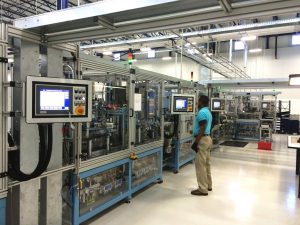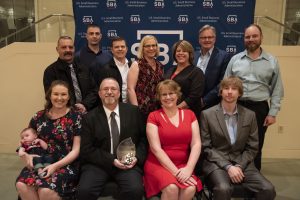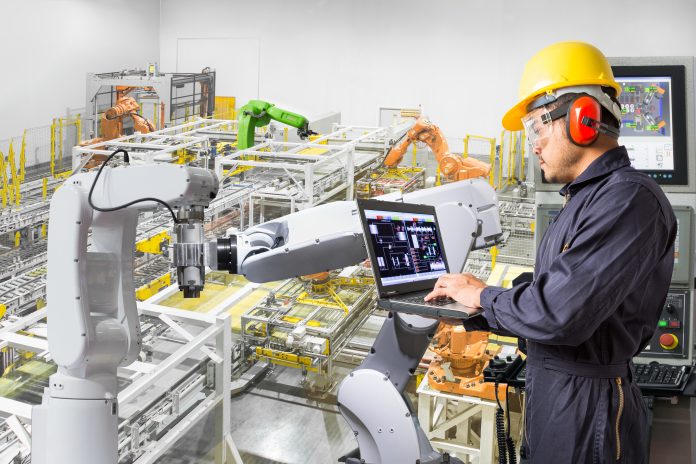While many economists and cultural commentators continue to warn of doom and gloom for the American workforce over the coming industrial automation revolution, many experts in workforce and economic development see plenty to remain optimistic about, for the rank-and-file worker and upper decision makers alike. Throughout the nation, community colleges, economic development organizations and state-run organizations are on the cutting edge of identifying the new jobs necessary to compete, creating state-of-the-art curriculum and training centers, and recruiting the companies that best compliment the business climate and education resources in their communities.
There is no doubt that automation, robotics, cobotics, et al., is changing, and will continue to change, work as we know it – manual labor in particular. However, many experts believe the worries of mass layoffs and rapidly declining opportunities for American workers have been magnified and distorted. In other words, there is no reason to fear of a coming robot army coup d’etat. “This is where I think people are misguided. Just because you have a robot coming in doesn’t mean it replaces people. It replaces processes; it doesn’t replace people,” says Amy Brabham, the workforce development director for the city of Auburn, Alabama.

With more than 20 years of experience in workforce development, business recruitment, and education throughout Alabama, Brabham says her experience shows automation allows companies to invest in other areas of the business that may have been undercapitalized or overlooked due to the high labor costs inherent in product manufacturing.
“What we’ve seen here in Alabama is the more automation that comes in, in actuality, the more employees a company is able to have and at a higher wage,” adds Brabham. “It has completely wiped away the myth that a robot comes in and replaces people. That is just not true. Can I say it won’t happen anywhere? Of course not. But it’s just not what we’ve seen and that’s not what companies describe.”
While automation in the form of robots and cobots is replacing the need for humans to perform the highly repetitive tasks involved in manufacturing, new jobs are being created in the wake of this changing dynamic. The challenge is coordinating multiple pieces, including workplace training, community college curriculum and business recruitment efforts, while, at the same time, focusing on market trends to help predict future workforce needs.
“What we’ve seen here in Alabama is the more automation that comes in, in actuality, the more employees a company is able to have and at a higher wage.”
In Alabama, the Alabama Industrial Development Technology (AIDT), an independent agency under the umbrella of the state’s Department of Commerce, is charged with coordinating efforts between manufacturers, community colleges, and economic development agencies to guarantee a trained workforce is ready for a new company relocating to the area or an existing one with new needs.
“When we start calculating numbers in different sectors of what we’ve got to have, and discover we have a gap,” Brabham says, “we turn around and work with AIDT and our community colleges to tailor-make either a short program of say four-to-six weeks of up-skill training, or maybe we need a six month program so that we can have these people at least familiar with the jobs they’re going to be applying for.
“That’s been a pretty strong effort so that people like me, on this side of the fence, can have some sort of workforce pool for our industries to pull from,” adds Brabham.
Alabama has been on the leading edge of manufacturing growth following Daimler-Chrysler’ decision to locate its first North American plant Mercedes-Benz in Vance, a small community just 25 minutes from Tuscaloosa and 25 minutes from Birmingham. The Mercedes M-Class SUV began rolling off the assembly line in 1996, and in the years since the Yellowhammer State attracted five additional auto manufacturers to Alabama – Honda, Hyundai, Toyota, Autocar, and New Flyer – with 40,000 individuals across the state working in that sector alone.
The growth in auto manufacturing over the last two decades has led to a manufacturing renaissance in the state. However, realizing the need to stay competitive, in 2009 then-governor Bob Riley established the Robotics Technology Park (RTP), a tax-funded collaboration between the state of Alabama, the Alabama Community College System, the Alabama Industrial Development Training agency (AIDT), and robotics industry leaders across the nation. Any company with a physical presence in Alabama can send employees to the RTP for training at no cost to the company.
“Governor Riley wanted to be able to attract business to Alabama and then be able to train those employees here in our home state,” says Kristi Bain, Assistant Director of North Alabama AIDT which oversees the RTP’s operations. “So, the purpose of the park and its mission is to help Alabama manufacturing companies and other companies be able to train their own with very little expense on the company.”
Reporting to the Department of Commerce, the AIDT helps companies locating to Alabama or already established companies in the state recruit a workforce, then, through the RTP, can train that workforce as well, giving the state a competitive advantage. Bain says the RTP has raised eyebrows among industry leaders around the world with this novel approach to workforce development that goes far beyond the usual government handouts. “It’s not just about ‘there’s a great piece of land and we’re going to give you these abatements and here’s your tax incentives on your electrical bill and other things that every other state can do,'” says Bain. “Instead it’s ‘let me tell you how we can find your workers and let me tell you how we can train your workforce.'”
Scenarios like these are playing out all over the country, including the northeast corner of Oregon in Clackamas County. A growing region of the state, Clackamas County is home to several high tech and manufacturing companies all facing the same issues, namely, what are the skills necessary in a modern and competitive workforce, and how are they going to be trained. William Fisher, the director of business & workforce solutions at Clackamas Community College in Oregon City, Oregon is one of the community leaders working to solve the problem. For instance, the community college is hosting the Automation and Robotics Workforce Summit on June 13, a conference of industry heads throughout Oregon with the purpose of developing the proper curriculum for the future.

“We’re inviting about a hundred and twenty businesses in the Clackamas County area to come in and literally have that conversation. ‘What are the skill sets and competencies that we should be training so that we can build programs for them now in the academic world in terms of certificates and Associate degrees,” says Fisher. The skills many of these companies are looking for fall under the term mechatronics. Essentially the blending of mechanical engineering and electronic skills, mechatronics first appeared as the buzzword about 10 years ago in economic development and high-tech circles, however, it still may be a term some of our readers are not familiar with. Regardless, of your level of familiarity of the term, it is the case that the training opportunities for mechatronics are just starting to take shape.
“In the academic world, meaning certificates, associates degrees and those kinds of credentials, it can take two-to-three years to get programs in place to be able to award those academic credentials,” Fisher says. “However, the division that I work in is called Customized Training, and what we do is work with the employers and put training programs together to pilot what might be successful to put into a degree program.”
“The new Workforce is being asked to be problem solvers and to add continuously to the process.”
Whether the company is based in Oregon, Alabama or anywhere in between, automation will require individual workers who are cross-trained in multiple areas rather than a specialist trained in only one field.
“The new Workforce is being asked to be problem solvers and to add continuously to the process. We don’t need new hard tooling and we don’t need manufacturing engineers to come out on the floor and reset everything up,” adds Fisher. “We’re being asked for a workforce that knows their job well, and they know not only what they’re doing, but why they’re doing it so that when new modifications come in they can be handled on the fly.”
Back in Alabama, where automotive manufacturing has been a driving force since the mid-1990s, Brabham says while so much emphasis has been placed on two-year degrees and upper-level theoretical engineers with advanced degrees, she fears there will be a shortage of trained professionals to help connect those dots.
“There is this person we need in between that might be a bachelor leveled engineer type of person, but it needs to be an applied engineer, and we term that ‘engineering technologies,’ says Brabham. “How do we get to the point where we don’t have such stratification in training that we’re missing that whole middle management person who knows a little bit about hands-on and a little bit about theory, but doesn’t know only one or the other? Right now that’s sort of where we are.”
What, she says, they should be focused on is ensuring companies and education resources are in a constant training mode rather than assuming an individual is going to do a single job for his entire career, which is no longer a realistic expectation.
“We need to make sure we understand that person and that skill set, and we’re training that person for the next level that they’ll move up to because that job is probably not going to exist in five years,” says Brabham.
“We’ve got to be mindful of what’s coming so that employees are trained in that manner. They move up as the company’s technology moves up,” Brabham adds. “So instead of looking at it as ‘your job doesn’t exist,’ it’s ‘we’re going to train you for the next level of job that does exist.'”




















